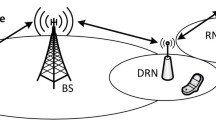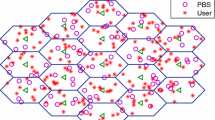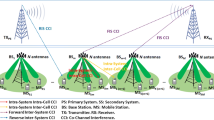Abstract
In this paper, we present a framework of link capacity analysis for optimal transmission over uplink MCN (Multi-hop Cellular Network) environments. An overlaid architecture is employed as the network topology, i.e., single-hop transmission over the inner region and multi-hop transmission over the outer region. In particular, we analyzed the gain that accrued from grafting a relay method onto a conventional, SCN (Single-hop Cellular Network) and investigated the conditions for optimal performance through the numerical results. At high-user density, a MCN exhibits a much more reliable transmission than the SCN. For maximal link capacity, optimal region partitioning is approximately accomplished at the normalized cell radius of 0.6 in most of cases for region division. Finally, the link capacity can be improved 1.2–1.8 times better than the SCN when the number of relay hops is 1.6 and the half-duplex mechanism is used. In addition, the proposed MCN scheme demonstrates an effective reduction in transmission power relative to the SCN.













Similar content being viewed by others
References
Lin, Y.-D., & Hsu, Y. C. (2000). Multihop cellular: A new architecture for wireless communications. INFOCOM, 3, 1273–1282.
Wu, H., Qiao, C., De, S., & Tonguz, O. (2001). Integrated cellular and ad hoc relaying systems: iCAR. IEEE Journal on Selected Areas in Communication, 19, 2105–2115.
Dawy, Z., Davidovic, S., & Oikonomidis, I. (2003). Coverage and capacity enhancement of CDMA cellular systems via multihop transmission. GLOBECOM, pp. 1147–1151.
Li, H., Yu, D., & Chen, H. (2003). New approach to multihop-cellular based multihop network. IEEE PIMRC, 2, 1629–1633.
DeFaria, M., & Sousa, E. S. (2005). Effect of intercell interference on the SNIR of a multihop cellular network. IEEE VTC Spring, 5, 3107–3111.
Fujiwara, A., Takeda, S., Yoshino, H., & Umeda, N. (2004). Evaluation of cell coverage and throughput i the multihop CDMA cellular network. IEEE VTC Spring, 4, 2375–2378.
Sydir, J., et al. (2006). 802.16j (mobile multihop relay) usage models.
Bruno, R., Conti M., & Gregori, E., (2005). Mesh networks: Commodity multihop ad hoc networks. IEEE Communications Magazine, 43(3), 123–131.
Lee, C.-C., & Steele, R. (1995). Signal-to-interference calculation for modern TDMA cellular communication system. IEE Proceedings Communication, 142(1), 21–30.
Cho, J., & Hong, D. (2002). Statistical model of downlink interference for the performance evaluation of CDMA systems. IEEE Communications Letters, 6(11), 494–496.
Hekmat, R., & Van Mieghem, P. (2004). Interference in wireless multi-hop ad-hoc networks and its effect on network capacity. Wireless Networks, 10(4), 389–399.
Ji, H., & Huang, C. Y. (1998). Non-cooperative uplink power control in cellular radio systems. Wireless Networks, 4(4), 233–240.
Ananthapadmanabha, R., Manoj, B. S., & Murthy, C. S. R. (2001). Multi-hop cellular networks: The architecture and routing protocols. PIMRC, 2, 389–399.
Chen, D., et al. (2006) Channel models and performance metrics for ieee 802.16j relay task group.
Hasna, M. O., & Alouini, M. S. (2003). Outage probability of multihop transmission over nakagami fading channels. IEEE Communication Letters, 7(5), 216–218.
Yanmaz, E., & Tonguz, O. K. (2004). Dynamic load balancing and sharing performance of hybrid wireless networks. IEEE Journal on Selected Areas in Communications, 22(6), 862–872.
Yanmaz, E., & Tonguz, O. K. (2008). The mathematical theory of dynamic load balancing in cellular networks. IEEE Transactions on Mobile Computing, 7(12), 1504–1518.
Dixit, S., Yanmaz, E., & Tonguz, O. K. (2005). On the design of self-organized cellular wireless networks. IEEE Communications Magazine, 43(7), 76–83.
Author information
Authors and Affiliations
Corresponding author
Additional information
This work was supported by the IT R&D program of MKE/KEIT [2009-S-032-01, Research on Multiple Antenna and Multi-hop Relay Transmission Technologies for Next Generation Mobile Broadcasting Service].
Appendix
Appendix
1.1 Interference from the multi-hop network
In this section, the means and variances of the interference terms \(I_{0_{m},SN}\) and I BS,ON in (9) and (12) are derived, which are caused by the multi-hop transmission of other MSs in R o .
1.1.1 The means of \(I_{0_{m},SN}\) and I BS,ON
The mean of \(I_{0_{m},SN}\) in (15) is given by \(m_{I_{0_{m},SN}}\)
and the mean of I BS,ON in (16) is given by \(m_{I_{BS,ON}}\)
where \(x_{j_{x}}=1\) for the active state and \(x_{j_{x}}=0\) for the inactive state according to the RF and pipeline transmission. Since the distance and transmission power between two adjacent nodes at the multi-hop network is relatively short and small not to affect the entire system performance, the path-loss gain \(G_{j_{x},0_{m}}\) and \(G_{j_{x},BS}\) can be approximated by only the distance factor \(r_{j_{x},0_{m}}^{-l_{1}}\) and \(r_{j_{x},BS}^{-l_{1}}\) without the use of the shadowing factor.
1.1.2 The variances of \(I_{0_{m},SN}\) and \(I_{BS,ON}\)
The variance of \(I_{0_{m},SN}\) in (15) is given by \(\sigma_{I_{0_{m},SN}}^{2}\)
and the variance of I BS,ON in (16) becomes \(\sigma_{I_{BS,ON}}^{2}\)
1.2 Interference from the single-hop network
In this section, the means and variances of the interference terms \(I_{0_{m},ON}\) and I BS,SN in (8) and (10) are derived, which are caused by the single-hop transmission of other MSs in R i .
1.2.1 The mean and variance of \(I_{0_{m},ON}\)
\(I_{0_{m},ON}\) can be divided into two components. One is the intra-cell interference (K = 0) and the other is the inter-cell interference (K ≠ 0), which are given by
Therefore, the inter-network interference \(I_{0_{m},ON}\) in (8) is given by
Using the criterion in (3), the interference term \(I_{j_x,K;0_{m}}\) in (23) is then expressed by
where \(r_{j_{x},K}\) and \(\xi_{j_{x},K}\) are the distance and the shadowing factor between the xth MS in the jth cell and the Kth BS. In addition, \(r_{j_{x},0_{m}}\) and \(\xi_{j_{x},0_{m}}\) are the distance and the shadowing factor between the xth MS in the jth cell and the mth MS in the 0th BS.
The mean of \(I_{j_x,K;0_{m}}\) in (24) can be written by
The probability \(P_{j_x,K}(K=k,\xi_{j_x,k}=\xi_{0})\) is then
Let S D be the initial pilot power from each BS. Assume that the pilot signal of the kth BS is the strongest for the MS at the “x” position of the jth cell. Then,
where 0 \(\leqq i \leqq N_{OC}\) and i ≠ k. Set \(\xi_{k\;,j_x} = \xi_{j_x,\;k} =\xi_{0}, \xi_{i,\;j_x} = \xi_{j_x,\;i}\) and \(r_{k,\;j_x} =r_{j_x,\;k}\) . Then,
Thus, \(P_{j_x,\;K}(k|\xi_{0})\) in (27) yields \(P_{j_x,\;K}(k|\xi_{0}) = Pr[S_{k,\;j_x}^{D}=\max(S_{i,\;j_x}^{D})|\xi_{0}]\)
where \(\sigma_{i,j_x}\) is set to a constant σ0. W.r.t. the 0th BS, the following condition must be satisfied:
The conditional expectation in (26) is \(E[I_{j_x,K;0_{m}}|k,\xi_{0}]\)
Thus, \(E[I_{j_x,K;0_{m}}]\) , \(V[I_{j_x,\;K;0_{m}}]\) are obtained by (27) and (30):
Therefore, the mean and variance of \(I_{0_{m},ON}\) are
1.2.2 The mean and variance of I BS,SN
IBS,SN can be divided into the intra-cell (K = 0) and inter-cell interferences (K ≠ 0) by
Therefore, the intra-network interference IBS,SN in (10) is given by
Then, the mean and variance of IBS,SN can be derived like \(E[I_{0_{m},ON}]\) , \(V[I_{0_{m},ON}]\)
Therefore, the mean and variance of \(I_{j_{x},K;BS}\) are
Rights and permissions
About this article
Cite this article
Lee, S., Lee, S. Optimal transmission methodology for QoS provision of multi-hop cellular network. Wireless Netw 16, 1313–1327 (2010). https://doi.org/10.1007/s11276-009-0205-y
Received:
Accepted:
Published:
Issue Date:
DOI: https://doi.org/10.1007/s11276-009-0205-y




